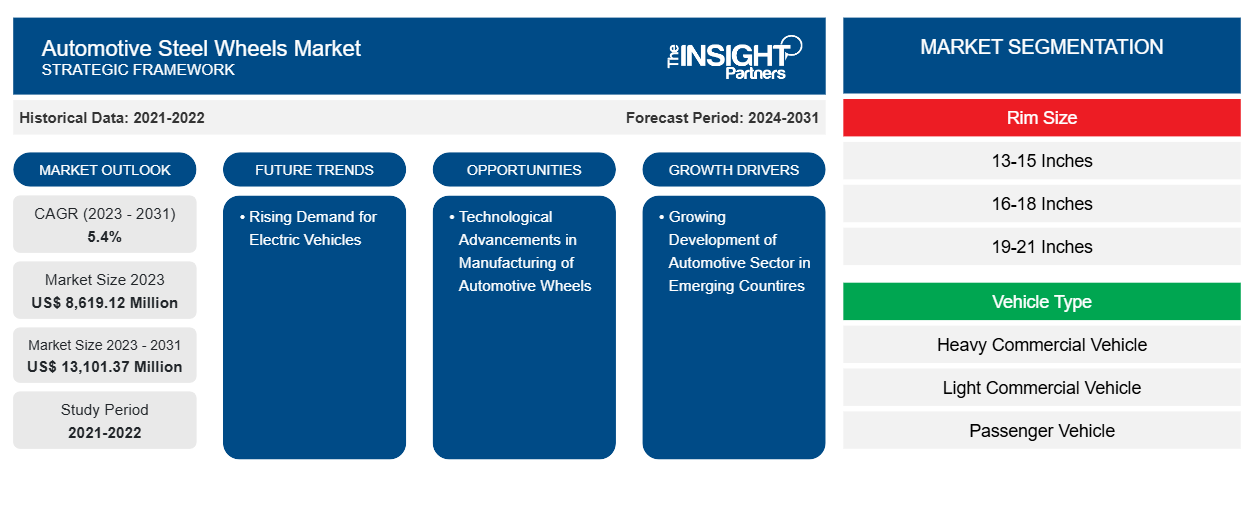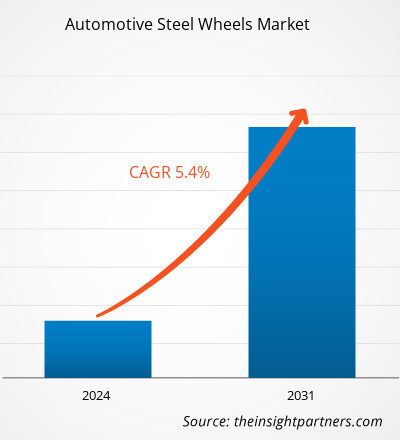The automotive steel wheels market size is projected to reach US$ 13,101.37 million by 2031 from US$ 8,619.12 million in 2023. The market is expected to register a CAGR of 5.4% during 2023–2031. The growing consumer inclination towards procuring lightweight steel wheels is likely to remain a key trend in the market.
Automotive Steel Wheels Market Analysis
The end-users for the automotive steel wheels market include OEM and aftermarket users. The OEMs are the users comprised of vehicle manufactures who use the wheels as a component of the vehicles assembled. The aftermarket users consist of individual customers of the vehicles, such as cars, trucks, and others. These users directly purchased as a separate product from the retail or wholesale stores. These users have a wide range of options, and the marketing offers very much influence the buying behavior. The growing demand for flooring materials is projected to boost the evolution of the global automotive steel wheels market during the forecast period of 2024-2031.
Automotive Steel Wheels Market Overview
The automotive steel wheels market's key stakeholders include raw material providers, manufacturers, distributors and channel partners, government bodies, industry associations, and end-users. In recent years, the demand for automotive steel wheels products based on the rim size and applications in different types of vehicles has grown at an remarkable pace owing to the rising need for lightweight wheels and increasing demand for economical automotive components. The raw material suppliers are essential parts in maintaining the quality of the products. As per the customer's requirement, the manufacturers develop and produce the products such as color combination, size, texture, and other specifications. In the automotive steel wheels market, a more significant number of manufacturers in the local and international markets offer a variety of automotive steel wheel products and services.
Customize This Report To Suit Your Requirement
You will get customization on any report - free of charge - including parts of this report, or country-level analysis, Excel Data pack, as well as avail great offers and discounts for start-ups & universities
Automotive Steel Wheels Market: Strategic Insights

-
Get Top Key Market Trends of this report.This FREE sample will include data analysis, ranging from market trends to estimates and forecasts.
Automotive Steel Wheels Market Drivers and Opportunities
Growing Development of Automotive Sector in Emerging Countries to Favor Market
The growing sales of passenger and commercial cars in developing nations like India, China, and Japan among others, are boosting the demand for automotive steel wheels market. The booming automotive sector and rising adoption of advanced technologies by OEMs in the automotive sector are anticipated to propel the growth of the automotive steel wheels market globally. The automotive OEMs are focusing on introducing various advanced features that improve vehicle competence, efficiency, and visual aesthetics, among other performance indicators in the vehicle. Among these, the automotive automotive steel wheels can be explained as a specially designed feature. The growing consumer preference for more comfort and easy driving technologies is fostering the growth of the automotive steel wheels market worldwide.
Rising Demand for Electric Vehicles
The growing environmental pollution due to fossil fuels is one of the major concerns for the government. To reduce the level of environmental pollution, various governments are emphasizing consumers adopting cleaner, sustainable, and environment-friendly alternatives in daily life by giving special rebates on sales, incentives, lucrative offers, and tax benefits. China, Japan, the European Union, India, Canada, and South Korea are some of the major geographies where governments are actively working towards boosting the adoption of passenger electric vehicles, which is anticipated to drive the development of the automotive steel wheels market over the forecast period.
Automotive Steel Wheels Market Report Segmentation Analysis
Key segments that contributed to the derivation of the automotive steel wheels market analysis are rim size, vehicle type and end user.
- Based on the rim size, the automotive steel wheels market is divided into 13-15 inches, 16-18 inches, 19-21 inches, and more than 21 inches. The 13-15 Inches segment held a larger market share in 2023.
- Based on the vehicle type, the automotive steel wheels market is divided into heavy commercial vehicle, light commercial vehicle, and passenger vehicle. The passenger vehicle segment held a larger market share in 2023.
- Based on the end user, the automotive steel wheels market is divided into OEM and aftermarket. The OEM segment held a larger market share in 2023.
Automotive Steel Wheels Market Share Analysis by Geography
The geographic scope of the automotive steel wheels market report is mainly divided into five regions: North America, Asia Pacific, Europe, Middle East & Africa, and South & Central America.
The scope of the automotive steel wheels market report encompasses North America (the US, Canada, and Mexico), Europe (the UK, Germany, Italy, France, Russia, and the Rest of Europe), Asia Pacific (South Korea, Australia, India, Japan, China, and the Rest of Asia Pacific), the Middle East & Africa (South Africa, Saudi Arabia, the UAE, and the Rest of Middle East & Africa), and South & Central America (Argentina, Brazil, and the Rest of South & Central America). In terms of revenue, Asia Pacific dominated the automotive steel wheels market share in 2023. North America is the second-largest contributor to the global automotive steel wheels market, followed by Europe.
Automotive Steel Wheels Market Regional Insights
The regional trends and factors influencing the Automotive Steel Wheels Market throughout the forecast period have been thoroughly explained by the analysts at The Insight Partners. This section also discusses Automotive Steel Wheels Market segments and geography across North America, Europe, Asia Pacific, Middle East and Africa, and South and Central America.
Automotive Steel Wheels Market Report Scope
| Report Attribute | Details |
|---|---|
| Market size in 2023 | US$ 8,619.12 Million |
| Market Size by 2031 | US$ 13,101.37 Million |
| Global CAGR (2023 - 2031) | 5.4% |
| Historical Data | 2021-2022 |
| Forecast period | 2024-2031 |
| Segments Covered |
By Rim Size
|
| Regions and Countries Covered |
North America
|
| Market leaders and key company profiles |
|
Automotive Steel Wheels Market Players Density: Understanding Its Impact on Business Dynamics
The Automotive Steel Wheels Market is growing rapidly, driven by increasing end-user demand due to factors such as evolving consumer preferences, technological advancements, and greater awareness of the product's benefits. As demand rises, businesses are expanding their offerings, innovating to meet consumer needs, and capitalizing on emerging trends, which further fuels market growth.

- Get the Automotive Steel Wheels Market top key players overview
Automotive Steel Wheels Market News and Recent Developments
The automotive steel wheels market is evaluated by gathering qualitative and quantitative data post primary and secondary research, which includes important corporate publications, association data, and databases. A few of the developments in the automotive steel wheels market are listed below:
- Maxion Wheels completed the construction and infrastructure of its new Maxion Janta 21,000 sq. meters commercial vehicle (CV) steel wheels plant in Manisa, Turkey. (Source: Iochpe-Maxion SA, Press Release, March 2021)
- Maxion Wheels opened its new truck steel wheels plant with partner Inci Holding in Turkey. The two companies also established a plant to offer forged aluminum Commercial Vehicle (CV) wheels in 2024. (Source: Iochpe-Maxion SA, Press Release, September 2022)
Automotive Steel Wheels Market Report Coverage and Deliverables
The “Automotive Steel Wheels Market Size and Forecast (2021–2031)” report provides a detailed analysis of the market covering below areas:
- Automotive steel wheels market size and forecast at global, regional, and country levels for all the key market segments covered under the scope
- Automotive steel wheels market trends as well as market dynamics such as drivers, restraints, and key opportunities
- Detailed PEST and SWOT analysis
- Automotive steel wheels market analysis covering key market trends, global and regional framework, major players, regulations, and recent market developments
- Industry landscape and competition analysis covering market concentration, heat map analysis, prominent players, and recent developments for the automotive steel wheels market
- Detailed company profiles
Frequently Asked Questions
Which region dominated the automotive steel wheels market in 2023?
What are the future trends of the automotive steel wheels market?
Which are the leading players operating in the automotive steel wheels market?
What would be the estimated value of the automotive steel wheels market by 2031?
What is the expected CAGR of the automotive steel wheels market?
- Historical Analysis (2 Years), Base Year, Forecast (7 Years) with CAGR
- PEST and SWOT Analysis
- Market Size Value / Volume - Global, Regional, Country
- Industry and Competitive Landscape
- Excel Dataset
Recent Reports
Related Reports
Testimonials
Reason to Buy
- Informed Decision-Making
- Understanding Market Dynamics
- Competitive Analysis
- Identifying Emerging Markets
- Customer Insights
- Market Forecasts
- Risk Mitigation
- Boosting Operational Efficiency
- Strategic Planning
- Investment Justification
- Tracking Industry Innovations
- Aligning with Regulatory Trends





















 Get Free Sample For
Get Free Sample For